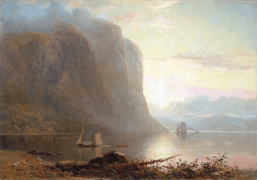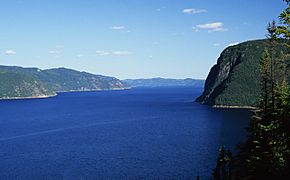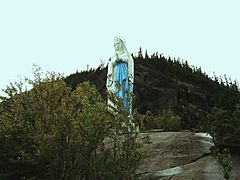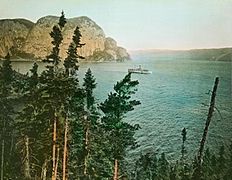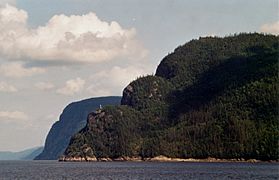Cap Trinité facts for kids
Quick facts for kids Cap Trinité |
|
|---|---|
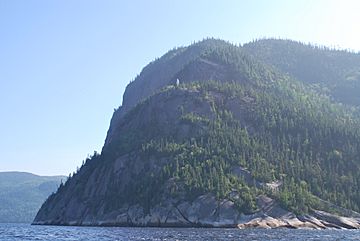
View of Cap Trinité overlooking the Saguenay
|
|
| Highest point | |
| Elevation | 411 m (1,348 ft) |
| Geography | |
| Country | Canada |
| State/Province | Quebec |
| Parent range | Laurentian Plateau |
| Geology | |
| Mountain type | Cliff |
| Climbing | |
| First ascent | 1967 (rock face) |
Cap Trinité is a huge rock cliff in Quebec, Canada. It's like a giant wall made of three big steps or levels. This amazing cliff stands tall over Éternité Bay and the Saguenay River. You can find it inside the beautiful Saguenay Fjord National Park. A famous statue, the Statue of Notre-Dame-du-Saguenay, is also located here.
Contents
What's in a Name?
The name "Cap Trinité" comes from how the cliff looks. It has three distinct parts, almost like three separate "caps" or peaks stacked on top of each other. One writer, Arthur Buies, described it as "three equal caps of size and elevation." This unique shape reminded people of the Holy Trinity, giving the cape its name.
Visiting Cap Trinité
Cap Trinité is one of the most popular spots in Saguenay Fjord National Park. Many people visit to see its impressive size and the stunning views it offers of the fjord. It's a great place for nature lovers and adventurers.
Stories and Art
An Old Legend
Long ago, the Innu people (also called Montagnais) told a special story about Cap Trinité. They said that the first Montagnais man, named Mayo, was paddling on the Saguenay River. Suddenly, a scary monster appeared from the water and attacked him!
Mayo was very brave. He grabbed the creature by its tail and slammed it against the mountain. He hit it once, then twice. On the third hit, the monster was finally crushed. This is why, according to the legend, Cap Trinité has three levels. The story also says that where the monster hit the rock, no plants could ever grow again.
Inspired by the Cliff
The beauty of Cap Trinité has inspired many artists and writers.
- In 1873, a poet named Louis-Honoré Fréchette wrote a poem called Le cap Trinité. He described it as a "huge pan of rock" that stands strong against storms.
- Another artist, Charles Gill, also found inspiration in the Saguenay capes. His poem, "Le Cap Trinité," talks about the rock showing "God's majesty" and its "three enormous bleachers" rising to the sky.
Photo gallery
-
The Saguenay River and the Cap Éternité seen from the first level of Cape Trinity near the Statue of Notre-Dame-du-Saguenay
Images for kids


